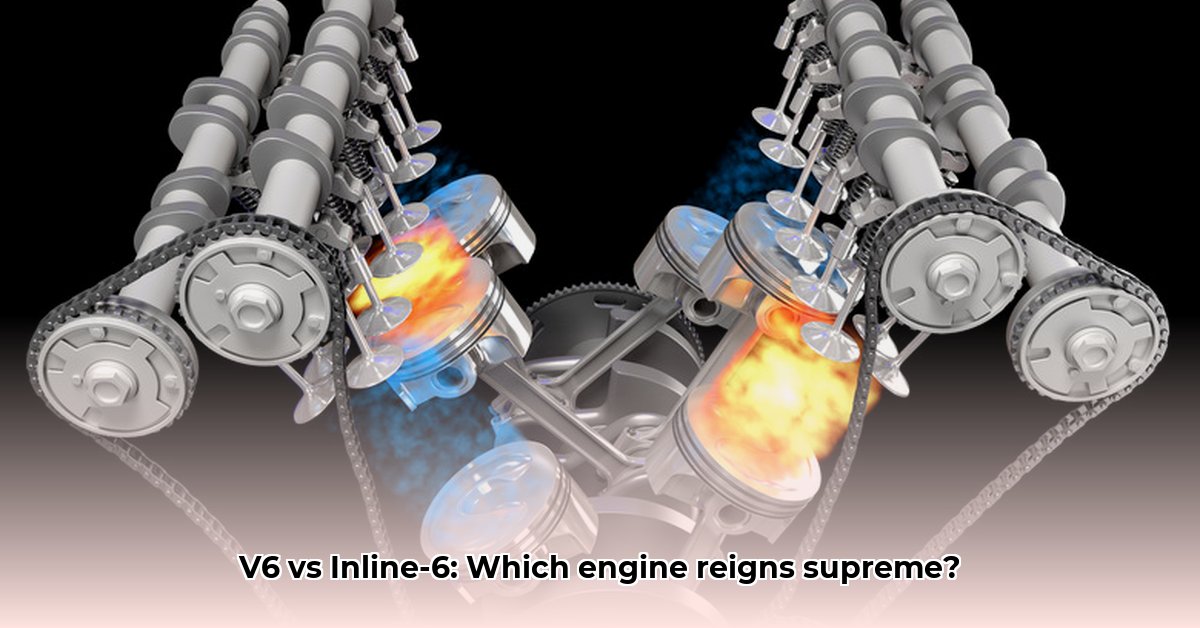
Choosing the right engine for your vehicle is a crucial decision, impacting performance, fuel efficiency, and cost. Two popular choices are V6 and inline-6 engines, each with its own strengths and weaknesses. This guide provides a clear comparison, helping you make an informed decision.
Understanding Engine Configurations
The core difference between V6 and inline-6 engines lies in their cylinder arrangement. This seemingly simple difference profoundly impacts performance characteristics and manufacturing costs.
V6 Engines: The Compact Powerhouse
A V6 engine arranges six cylinders in two banks of three, forming a "V" shape. This configuration allows for a more compact engine, making it suitable for smaller vehicles where space is at a premium.
Pros of V6 Engines:
- Compact Design: Their smaller footprint makes them ideal for diverse vehicle applications, from compact cars to SUVs.
- Generally Lower Manufacturing Cost: Often less expensive to produce than inline-sixes, potentially resulting in lower vehicle prices.
- Versatile Platform: Easily adaptable to different vehicle types, making them a common choice among manufacturers.
Cons of V6 Engines:
- Potential for Vibration: The cylinder arrangement can lead to slightly more vibration than inline-sixes, though advancements have significantly minimized this in many modern V6s.
- Slightly Less Smooth Power Delivery: The inherent imbalances may result in a less refined power delivery than inline-sixes, a subtle difference often only noticeable to experienced drivers.
Inline-6 Engines: The Smooth Operator
An inline-six engine arranges its six cylinders in a straight line. This seemingly simple design results in exceptional balance, leading to smooth operation and a refined driving experience.
Pros of Inline-Six Engines:
- Unmatched Smoothness: The inherent balance minimizes vibrations, resulting in a remarkably smooth and refined engine operation, even at higher RPMs.
- Superior Durability: The smoother operation can contribute to longer engine lifespan, though proper maintenance is crucial for all engines.
- High Power Potential: Inline-six engines often boast higher horsepower and torque potential, especially in performance-oriented applications.
- Refined Driving Experience: The smooth power delivery and minimal vibrations enhance the overall driving experience.
Cons of Inline-Six Engines:
- Larger Footprint: Their length requires more space in the engine bay, limiting their use in smaller vehicles.
- Higher Manufacturing Costs: The precision engineering and size often translate to higher production costs.
- Packaging Challenges: The longer length can pose challenges in vehicle design, especially in front-wheel-drive cars.
V6 vs. Inline-6: A Direct Comparison
| Feature | V6 Engine | Inline-Six Engine |
|---|---|---|
| Size | Compact | Larger |
| Smoothness | Good, with improvements in modern designs | Exceptionally smooth, inherently balanced |
| Manufacturing Cost | Generally lower | Generally higher |
| Power Potential | Varies widely, generally lower peak power | Often higher, especially at higher RPMs |
| Fuel Efficiency | Varies depending on design and application | Varies depending on design and application |
| Maintenance | Varies depending on model and driving style | Varies depending on model and driving style |
| Typical Applications | Smaller cars, SUVs, crossovers | Luxury cars, performance vehicles, trucks |
Choosing the Right Engine: Factors to Consider
The "best" engine depends entirely on individual needs and priorities. Consider the following:
- Vehicle Size and Type: A compact V6 might be ideal for a smaller car, while a larger inline-six might better suit a luxury sedan or truck.
- Budget: V6 engines generally have lower upfront costs.
- Performance Expectations: Inline-six engines often deliver superior smoothness and higher potential power.
- Long-term Costs: Maintenance costs can vary significantly between engine types and models. Research specific models.
"Ultimately, the decision hinges on your driving style and preferences," says Dr. Emily Carter, Professor of Mechanical Engineering at MIT. "Both engine types offer excellent performance; the choice depends on prioritizing factors like space, cost, or driving refinement."
Key Takeaways: Making Your Decision
- Smoothness: Inline-six engines generally provide a smoother driving experience.
- Compactness: V6 engines offer a more compact design, suitable for smaller vehicles.
- Cost: V6 engines typically have lower manufacturing and initial purchase costs.
- Power: Inline-six engines often offer higher power potential.
- Application: The best choice depends on the vehicle's intended purpose and target market. Consider your needs carefully before making a final decision.
This comprehensive guide provides a balanced overview to help you choose the engine best suited to your requirements. Remember to research specific models within each engine type to make an informed decision.